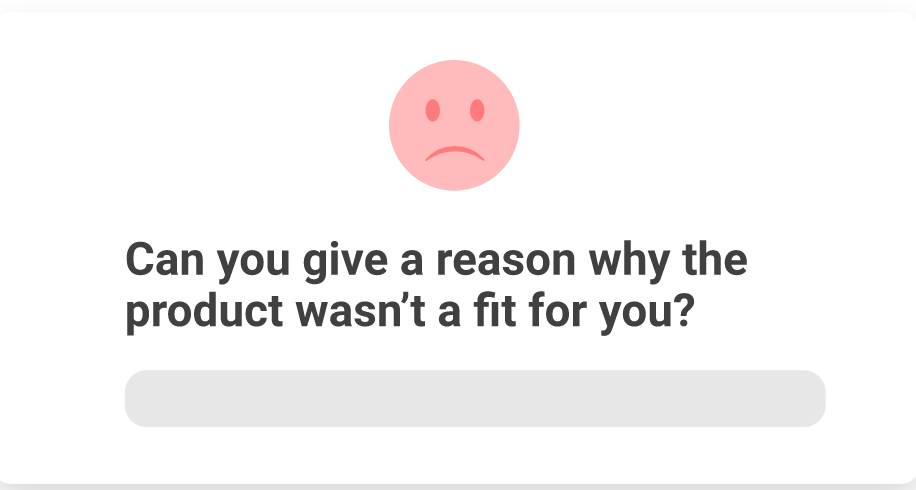5 Critical User Insights You Can Uncover with Surveys
You already know that improving the interactivity and engagement of your customer surveys can boost their effectiveness.
But how carefully are you examining those responses?
Survey analysis is useful because it enables you to derive conclusions about your target audience. The goal is to convert numbers into objectives that your teams can use to improve and expand your product, customer experience, customer support, and overall business.
Listening to your customer’s feedback is important for the success of your business. Data from a recent survey shows that 87% of respondents want to have a say in a company’s future products and services. So it is important for businesses to really listen to their customer’s feedback and gather helpful insights from them.
In this article, I will talk about five different types of insights you can gain from surveys and how they can benefit you.

Why Do SaaS Companies Need to Conduct Surveys?
For SaaS companies, effective B2B marketing requires investing in high conversion rate marketing tools and strategies. Surveys are one of the most interactive and effective ways to collect customer feedback with the primary goal of the customer experience. They can help you gain insights into the demographics of your customers. You can also get valuable comments, suggestions and opinions from your customers that you probably would not have considered otherwise.
Surveys can collect data that will help your business. They can inform your decision-making and influence innovations. They can also help you develop a strategy that fits the needs and desires of your customers. All of these will come together to increase customer satisfaction which will lead to a higher customer retention rate.
A good example of how to use survey data collection to improve operations is sending out website usability surveys. Ask questions about accessibility, content, navigation, load times, and more to understand if your website meets your customer’s needs.
How Many Kinds of Surveys Are There?
Different types of survey methods can help you provide different types of information and insights. The right method, of course, depends on your goals and sample size.
1. Exploratory Research
The purpose of exploratory survey research is to learn more about the research context. In this case, survey research focuses on generating new ideas and insights about the research subject(s) or context(s).Open-ended questions in exploratory survey research typically allow respondents to fully communicate their thoughts and varying perspectives on the subject matter. An exploratory research survey is often used to kick off a systematic investigation.
The most common example of exploratory research in online surveys is in the form of open-ended questions. You can use different tools like HockeyStack to create online surveys, automatically save your answers, and get access to real-time reporting and analysis.

2. Causal Research
Causal survey research looks for existing patterns to explain the relationship between two variables.
It is also known as conclusive research because it allows you to identify cause and effect. Predictive variables enable you to determine the nature of the relationship between the causal variables and the predicted effect.
3. Descriptive Research
In contrast to causal research, descriptive survey research is primarily observational. It is ideal for quantitative research because it aids in the collection of numerical data.
The descriptive survey research questions allow you to gain new insights into the actions, thoughts, and feelings of survey respondents. With this information, you can determine the extent to which various conditions can be obtained among these subjects.
5 Critical User Insights You Can Uncover with Surveys
Consumer insights can help businesses build their brand and sell their products more effectively. Some of the most valuable data you can gather from surveys will tell you why consumers behave the way they do.
You can find out how your customers feel about your brand, what marketing messages work best for them, and get feedback on products or campaigns. You can also collect data at different points in the customer journey to see how perceptions change over time. Here are 5 insights you can uncover with surveys:
- Customer Engagement: Responding to a survey is a clear sign of customer engagement. The fact that a customer takes the time to complete your survey shows that they care enough about your product and company to give you feedback. Identifying customers who regularly respond to Customer Satisfaction (CSAT) surveys means you can contact them about marketing activities like beta programs or request referrals and reviews.
- User Characteristics Who are your users? You may know their name and company, but who are they really? What is their industry? Such insights can help you find out who is using the product. For companies that are relatively new, these answers will help you find product/market suitability. They can also help create better onboarding and user experiences for businesses of all sizes and even guide marketing efforts.
- Possible Churn Risk Looking at only one customer satisfaction survey response at a time give you a very limited view of what your customers are really feeling. For example, if the same customer has submitted negative responses repeatedly in surveys, it’s time to scrutinize their needs. This customer is clearly consistently dissatisfied and the customer experience has not improved for them. Identify customers who are consistently dissatisfied by looking for customers with multiple negative CSAT responses over a specific time period. You can prevent them from cancelling their subscription or downgrading to a lower plan by connecting them to your customer success team or manager. A high churn rate means that you are spending more money on acquiring new customers. The lower the churn rate, the better.
Pro Tip:
A good way to analyze why you’re losing a customer is to use a churn rate survey. Try HockeyStack’s survey tool now!
4. Product & Service Enhancements By collecting customer feedback, you can get valuable design and feature-related feedback. You can ask questions to understand what your customers think about new features to improve feature adoption and adjust or create new products/services based on customer needs. By asking product-specific questions, you can also collect feedback that may give you a competitive advantage.
5. Traffic Sources When you see ‘direct’ in your traffic analytics, you have no idea how they found you. This is especially problematic for B2B product companies because the purchasing process frequently involves more than one person. For instance, one person may discover your website while another registers for an account or schedules a demo.
Furthermore, some people clear their cookies or use private mode when comparing solutions to avoid being bombarded with advertisements. As a result, your direct channel’s profitability is likely to be overestimated. Surveys can be used to learn how customers find you in order to gain a better understanding of how each channel affects your revenue.
Steps You Can Take to Create Better Surveys

Many factors determine the success of a survey. Some of the most important factors are cost, sample size and accuracy, time to collect responses, and how the survey is distributed. Here are some steps you can follow to create better surveys:
Define the purpose of the survey
The purpose of the survey should be clear, and achievable. For example, you may want to understand why customers stopped using your product. In that case, the goal would be to understand the main factors that cause customer churn.
Keep the survey short and focused
Short and targeted help in terms of quality and quantity of answers. In general, it’s better to focus on a single goal than to create a very long survey that covers multiple goals. The shorter the survey, the higher the response rate and the less the chances of respondents quitting mid-way. Make sure each of your questions is aimed at achieving your stated goals and is clear and easy to understand for recipients.
Rephrase yes/no questions
Yes / No questions provide only one of two possible answers and therefore do not provide more detailed data than answer-scale or multiple-choice questions. That is why a mix of yes/no questions and multiple choice questions are necessary. This way, you increase your chances of getting better and more actionable responses from your customers.
Customer insights are a valuable resource weapon for understanding how to improve the customer experience in different ways. Not only can you better understand how to improve your existing products, but you can also use this data to develop new products and attract future customers.
For example, if your page’s design is too distracting, with too many pop-ups and sidebars that annoy your user, you’d like to know about it so you can fix the problem, right?
Request that your users share their thoughts and opinions in your surveys. People are more likely to participate in a survey if they believe their input is valuable and that they can make a difference.
With tools like HockeyStack, you can create different types of surveys with ease. For every use case, you can employ a wide range of survey formats, such as NPS, short text, long text, single select, multi-select, and more. You can also use HockeyStack to analyze each step of customers’ journey to get a better understanding and context to their survey responses.

FAQs
Surveys can be used for several purposes including:
Market research, customer satisfaction and brand awareness etc.
You can use surveys to collect a variety of information. The decision to use surveys depends entirely on what your goal is and who your audience is.
Background: Where are they from, age, etc.
How satisfied your customers are with your product
Possible product mistakes
Useful feedback for your business



